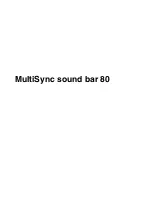
GOLDBERG AND MÄKIVIRTA
AUTOMATED IN-SITU EQUALISATION
AES 23RD CONFERENCE, May 23-25, 2003
3
oes and reverberation) rather than tone colouration.
This part of the time domain response contributes to
the sensations of envelopment and spaciousness.
2.3. Room Response Controls
The loudspeakers to be optimised have room response
controls [1,32]. The smaller loudspeakers have sim-
pler controls than the larger systems but the philoso-
phy of filtering is consistent across the range (Tables
1-4).
Table 1. Small two way room response controls.
Control type
Room response control settings, dB
Treble tilt
0, –2
Bass tilt
0, –2, –4, –6
Bass roll-off
0, –2
Table 2. Two way room response controls.
Control type
Room response control settings, dB
Treble tilt
+2, 0, –2, –4, driver mute
Bass tilt
0, –2, –4, –6, driver mute
Bass roll-off
0, –2, –4, –6, –8
Table 3. Three way room response controls.
Control type
Room response control settings, dB
Treble level
0, –1, –2, –3, –4, –5, –6, driver mute
Midrange level
0, –1, –2, –3, –4, –5, –6, driver mute
Bass level
0, –1, –2, –3, –4, –5, –6, driver mute
Bass tilt
0, –2, –4, –6, –8
Bass roll-off
0, –2, –4, –6, –8
Table 4. Large system room response controls.
Control type
Room response control settings, dB
Treble tilt
+1, 0, –1, –2, –3
Treble level
0, –1, –2, –3, –4, –5, –6, driver mute
Midrange level
0, –1, –2, –3, –4, –5, –6, driver mute
Bass level
0, –1, –2, –3, –4, –5, –6, driver mute
Bass tilt
0, –2, –4, –6, –8
Bass roll-off
0, –2, –4, –6, –8
The
treble tilt
control
is used to reduce the high fre-
quency energy. In the small two-way systems and
two-way systems it is a level control of the treble
driver and has an effect down to about 4 kHz. In large
systems it has a noticeable effect only above 10 kHz
and has a roll-off character.
The
driver level
controls
can be used to shape the
broadband response of a loudspeaker. They control
the output level of each driver with frequency ranges
that are determined by the crossover filters.
The
bass tilt
control
compensates for a bass boost
seen when the loudspeaker is loaded by large nearby
boundaries [33-36]. This typically happens when a
loudspeaker is placed next to, or mounted into, an
acoustically hard wall. This filter is a first
order shelv-
ing filter.
The
bass roll-off
control
compensates for a bass
boost often seen at the very lowest frequencies the
loudspeaker can reproduce. This typically happens
when the loudspeaker is mounted in the corner of a
room where the loudspeaker is able to couple very ef-
ficiently to the room thereby exacerbating room mode
effects that dominate this region of the frequency re-
sponse. It is a notch filter with a centre frequency set
close to the low frequency cut-off of the loudspeaker.
3. ROOM EQUALISATION OPTIMISER
Optimisation involves the minimisation or maximisa-
tion of a scalar-valued objective function
E
(
x
),
( )
x
E
min
(1)
where,
x
is the vector of design parameters,
x
∈ℜ
n
.
Multi-objective optimisation is concerned with the
minimisation of a vector of objectives
E
(
x
) that may
be subject to constraints or bounds. Several robust
methods exist for optimising functions with design
parameters
x
having a continuous value range [37].
3.1. Efficiency of Direct Search
The room response controls of an active loudspeaker
form a discrete-valued set of frequency responses. If
the optimum is found by trying every possible combi-
nation of room response controls then the number of
processing steps becomes prohibitively high (Table 5).
Table 5. Number of setting combinations.
Type of loudspeaker
Room Response
Control
Large 3-way 2-way
Small
2-way
Treble tilt
5
-
4
2
Treble level
7
7
-
-
Midrange level
7
7
-
-
Bass level
7
7
-
-
Bass
tilt
5 5 4 4
Bass
roll-off
5 5 5 2
Total
42875
8575
80
16
3.2. The
Algorithm
The algorithm [38] exploits the heuristics of experi-
enced system calibration engineers by dividing the
optimisation into five main stages (Table 6), which
will be described in detail. The optimiser considers




































